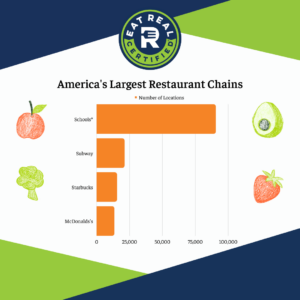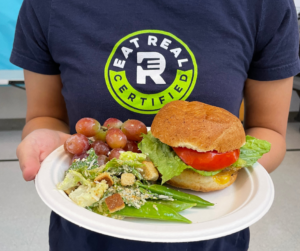 Each day in America, thousands of school foodservice workers spend their days in kitchens and cafeterias preparing meals for our nation’s students. In big cities and small towns, as students roll in, cafeterias are busy getting ready to feed the roughly 30 million children who eat school food every day.
Each day in America, thousands of school foodservice workers spend their days in kitchens and cafeterias preparing meals for our nation’s students. In big cities and small towns, as students roll in, cafeterias are busy getting ready to feed the roughly 30 million children who eat school food every day.
If you treat our nation’s school systems as a restaurant chain, there are more locations serving meals every day than Subway, Starbucks, and McDonald’s combined. This massive amount of purchasing power presents America’s schools with an unprecedented opportunity to shift demand for products that are grown and raised using practices that help improve, as opposed to degrade, our planet.
Recognizing this opportunity, central components of Eat Real’s Certification program focus on helping school districts source more sustainably and reduce wasted food. For example, we help school districts re-localize their food sourcing by shifting purchasing away from large foodservice companies and focusing more on buying from local farmers selling in-season produce. This helps drastically reduce the number of transportation miles it takes to get food from farm to fork. In fact, researchers estimate that carbon emissions from transporting food are about 6% of the global total.
But creating more sustainable school meals is about much more than simply where food is sourced from. Across our partner school districts, there is also a commitment to minimizing food waste by adopting practices like bulk stations, share tables, and compost programs that help keep as much food as possible out of landfills.
Learn more about how Eat Real is a top climate solution in our CEO’s new TED Talk, Eat Climate Change, from the Planetary Stewardship Conference.
The leading food waste non-profit organization ReFED estimates that 24% of all food in the U.S. goes to waste–that represents 90 billion meals per year! Cutting food waste by half in the U.S. would reduce greenhouse gas emissions by 75 million metric tons each year – the same as taking 16 million gas-powered cars off the road.




Here are a few real-world highlights from Eat Real’s school partners showing the impact that is possible:
- In Mt. Diablo Unified School District, school foodservice staff have led an overhaul of the district’s sourcing leading to new partnerships with purveyors like Mary’s Chicken, CreamCo Meats, and dozens of other local businesses.
- In Morgan Hill Unified School District, two Freight Farm shipping containers help the district grow nearly 70% of the lettuce they need for all the schools in the district
- In Vacaville Unified School District, there is a concerted effort to create relationships with local farms and producers, many of which did not previously sell to schools. This has helped the school district weather supply-chain disruptions and expand their scratch-cooked meal offerings.
- In San Luis Coastal Unified School District, plant-powered items like Thai basil lentil burgers are menu staples and highlighted in “taste tests” where students learn about new ingredients and the farms that grow them.
Interested in learning more about how school meals can help heal the planet? Sign-up for updates from Eat Real’s experts.
